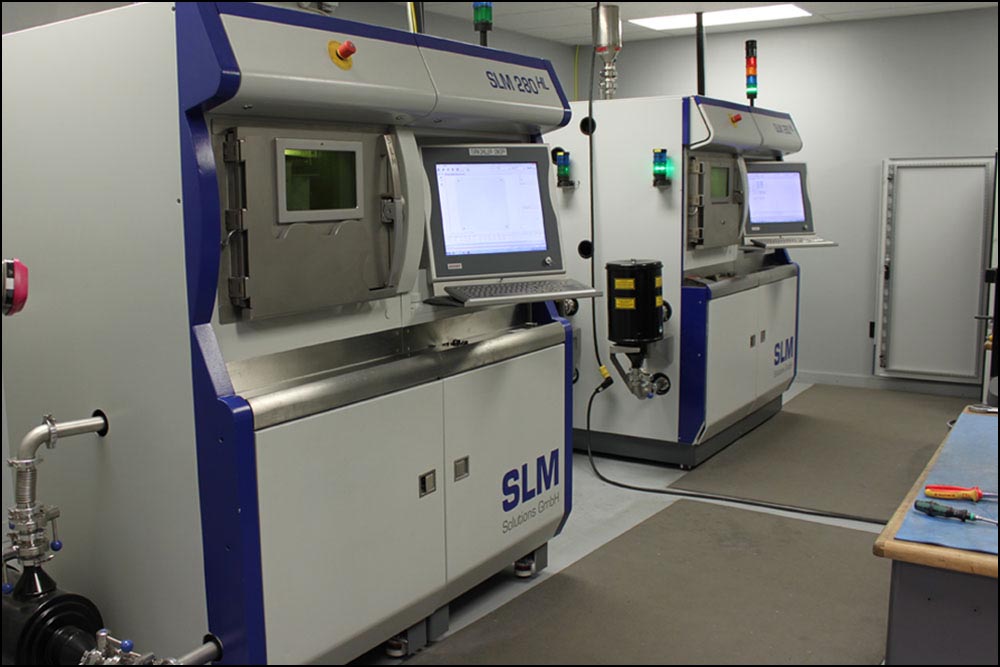By Wesley Hart
Imperial Machine & Tool Co. took delivery of their first metal additive manufacturing (AM) machine in 2013 — a Selective Laser Melting system from SLM Solutions. The decision to invest was made after seeing one of these “metal 3D printers” in action, growing a component layer-by-layer from titanium. That demonstration made it clear to Imperial that this was powerful technology, and would play an integral role in the future of advanced manufacturing.
Over the last four years, the folks at Imperial have spent thousands of hours working with their additive machines. According to Christian G. Joest, Vice President of Sales and Business Development at Imperial, that’s what it takes to be successful. “Metal AM has come a long way since its inception, but it’s not a turn-key operation; you’ve got to put in the time to master your machines and lock down your process. Early adopters must be willing to problem solve and learn along the way. We understood that, and decided to make the investment — even though the path forward was not entirely clear.”
The “dive-in” approach employed by Imperial has provided them with unique and useful insight — especially for those wondering how additive manufacturing will affect their own business. LIA invited Imperial to share some of their insight during a 30 minute presentation at the Industrial Laser Conference held at IMTS 2016. This article focuses on some of the key takeaways from that presentation.
Why Invest in Metal Additive Manufacturing?
Christian began the presentation by sharing some background on Imperial, and the primary reasons they decided to get into metal additive manufacturing.
“Imperial is a 73 year-old advanced manufacturing company. Since the 1940s, we’ve been known for tackling the most challenging machining and fabricating efforts in the industry. Our earliest work was for the military and we still do a large amount of work for the DoD, but over the years we’ve expanded to serve many other high-end sectors including the semiconductor, energy and optical equipment industries.
To be successful at challenging manufacturing projects, we rely on the most cutting edge manufacturing technology available; it’s one of the reasons we’ve remained competitive and relevant over the last seven decades and a big part of why we got into metal additive manufacturing. In the 40s that meant advanced Jig-boring machines, in the 70s it was CNC machining centers, and today it’s metal additive manufacturing. We wanted to get out in front of the technology.”
The second reason was more personal.
“The other reason we became involved in additive is because we’re a fourth-generation, family-run business. We consider investments in terms of decades and generations, and we believe metal AM will be required for success for the next generation of Imperial. We understood we wouldn’t see a financial return on our investment right away, but that wasn’t what was driving this decision; we wanted to begin developing expertise as early as possible.”
Christian went on to explain how the impact of additive will be felt across all industries in a variety of ways. For example, current Imperial customers working in laser and energy beam related industries are particularly interested in metal AM for the conformal cooling possibilities.
The Importance of Hybrid Manufacturing
As the presentation continued, Christian built to an important point, “It’s not just press print.”
Christian explained that customers are looking for high-quality end-use components. Additive manufacturing can help realize innovative new designs, but they are not pulled straight from the printer.
“Misconception comes with the territory; the technology is young. Most of the public doesn’t even know that printed parts are actually welded by laser to the build plate, and must be cut off!”
To successfully yield end-use components Imperial had to develop a “hybrid manufacturing” approach — using their additive capabilities in conjunction with their traditional machining capabilities. For example, they might use their metal printer to manufacture a topology optimized hydraulic manifold with complex internal channels, but they still rely on high-precision CNC machining centers to mill special SAE threads and flatten critical mating surfaces. That’s in addition to the thermal conditioning operations Imperial performs to yield the best material properties. All of these steps must be planned and accounted for before manufacturing begins! This is a far cry from pulling an end-use component straight from the printer.
The Real-World Applications of 3D Printing
Christian went on to explain the education process that must occur when interacting with new customers; getting the most out of additive manufacturing requires an understanding of what it’s best used for.
The value of AM is not in making the same part designed for CNC machining on a metal printer, it’s in realizing designs never before possible. Christian spoke of how Imperial works closely with their customers to ensure they understand the reality of when additive manufacturing makes sense, and when it does not.
“Over the years we developed a list that breaks down the best applications for additive manufacturing, based on our experience with customers and our background in manufacturing. Our goal is to provide a strong foundation for our customers to continue exploring from. Once customers understand these applications, they begin to think on their own about how additive manufacturing can positively affect their business and industry.”
A Look Toward the Future
As the presentation wound down, the focus turned to what it will take for metal AM to become mainstream. “You’re all here today because you’re interested in additive manufacturing on some level. That’s the first step. Don’t be afraid to explore further. You’re in the right place, at the right time in history to be a part of this emerging technology. Embrace the opportunity.”
Metal additive manufacturing is already making a big impact for Imperial Machine & Tool Co. and their customers. How will metal AM affect you, and what you do?
Wesley Hart is the Marketing Director of Imperial Machine & Tool Co.

